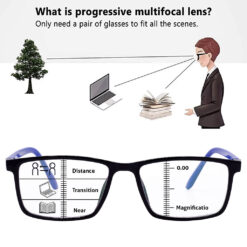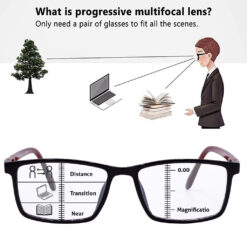Blog, Progressive Glasses
Progressive Glasses: Your Complete Guide to Clear Vision at Every Distance
Progressive glasses have revolutionized vision correction for millions of people worldwide, offering seamless clarity from near to far without the visible lines of traditional bifocals. If you’re considering progressive glasses or wondering whether they’re right for you, this comprehensive guide covers everything you need to know.
Progressive glasses use advanced multifocal lens technology to provide clear vision at all distances through a single pair of eyewear. Unlike bifocals that have distinct sections, progressive lenses feature a gradual transition from distance vision at the top to reading vision at the bottom, with intermediate vision in between. This makes them ideal for people with presbyopia, the age-related condition that typically begins around age 40 and affects close-up vision.
Products by Category
-
Hrinkar Blue Cut +1.00 Progressive Reading Glasses for Men and Women with Anti Glare Lens | Black & Brown | HRPRO15-BK-BWN-100
Original price was: ₹2,990.00.₹1,490.00Current price is: ₹1,490.00. -
Hrinkar Progressive Reading Glasses for Men and Women with Blue Cut Reading Glass and Anti Glare Lens | Black & Blue | HRPRO16-BK-BU
Original price was: ₹2,990.00.₹1,490.00Current price is: ₹1,490.00. -
Hrinkar Blue Cut Progressive Reading Glasses for Men and Women with Anti Glare Lens | Black & Red | HRPRO11-BK-RD
Original price was: ₹2,990.00.₹1,490.00Current price is: ₹1,490.00.
What Are Progressive Glasses and How Do They Work?
Progressive glasses contain specially designed lenses that incorporate three different prescriptions within one seamless surface. The upper portion provides clear distance vision for activities like driving or watching television. The middle section offers intermediate vision perfect for computer work or viewing objects at arm’s length. The bottom portion handles near vision tasks such as reading books or checking your phone.
The magic lies in the gradual power transition. Unlike traditional bifocals that create an abrupt change between viewing zones, progressive lenses offer a smooth gradient that mimics natural vision. This eliminates the jarring “image jump” that bifocal wearers often experience when shifting their gaze between different distances.
The Science Behind Progressive Lens Design
Modern progressive lenses use digital surfacing technology to create precise optical zones. Manufacturers like Essilor, Zeiss, and Hoya employ sophisticated algorithms to map the lens surface, ensuring optimal clarity while minimizing peripheral distortion. The result is a lens that provides up to 40% wider viewing areas compared to standard designs.
Benefits of Progressive Glasses vs Traditional Alternatives
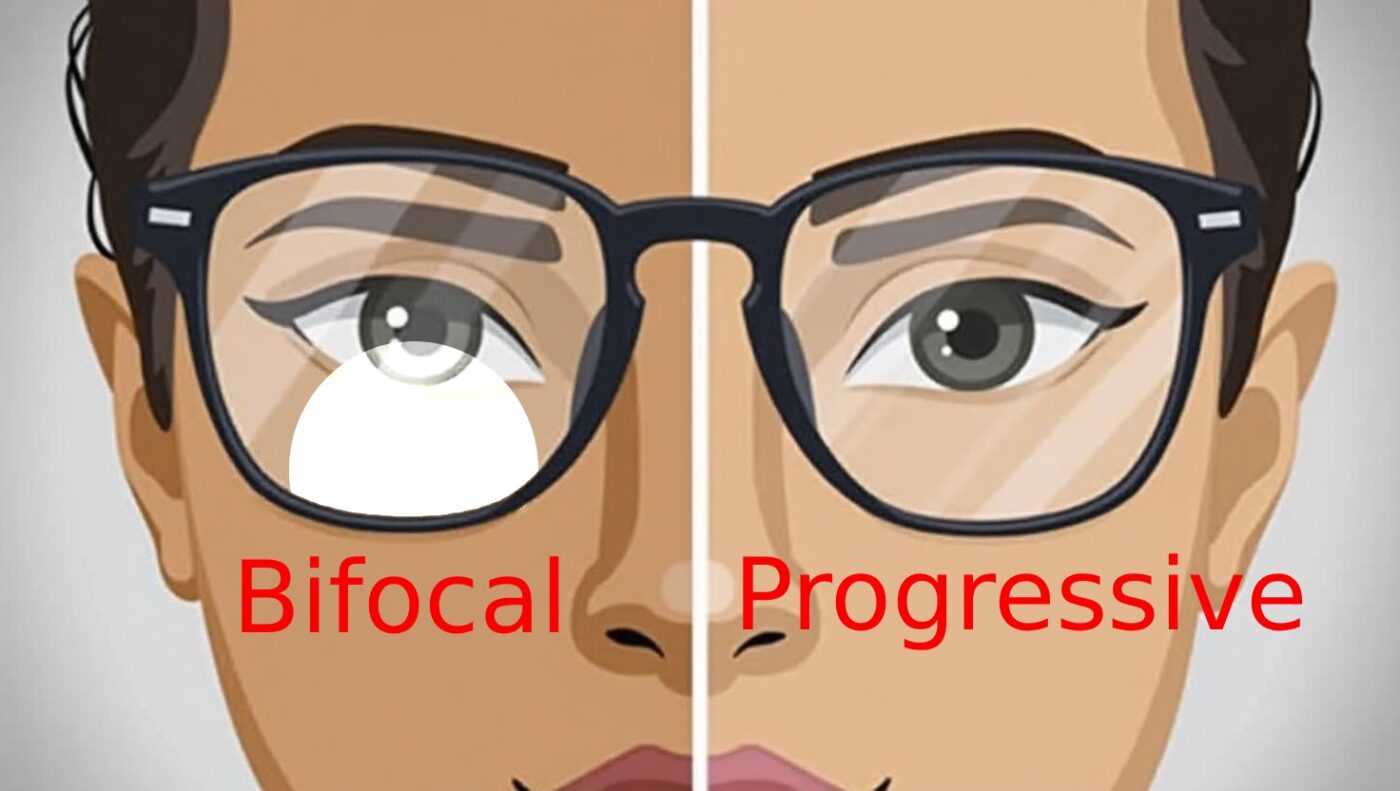
Convenience and Lifestyle Advantages
The primary benefit of progressive glasses is convenience. Instead of juggling multiple pairs of glasses or constantly switching between distance and reading glasses, you need just one pair. This is particularly valuable for busy professionals who frequently transition between tasks requiring different focal distances.
Aesthetic and Social Benefits
Progressive glasses offer a more youthful appearance since they lack the visible bifocal line. Many people find bifocals make them look older, while progressive lenses maintain the sleek appearance of single-vision glasses. This aesthetic advantage often boosts confidence, especially for first-time multifocal wearers.
Enhanced Visual Experience
The smooth transition between viewing zones provides a more natural visual experience compared to the distinct sections of bifocals. You can enjoy uninterrupted vision whether reading a menu at a restaurant, checking your computer screen, or looking across the room.
Types and Features of Progressive Lenses
Standard vs Premium Progressive Lenses
Standard Progressive Lenses typically cost between $175-$250 and offer basic multifocal correction with narrower reading zones. While functional, they may have more peripheral distortion and require longer adjustment periods.Premium Progressive Lenses range from $600-$800 but provide significantly wider viewing zones, reduced distortion, and faster adaptation. Brands like Zeiss SmartLife Individual 3 and Essilor Varilux XR incorporate AI-driven designs that customize the lens based on your lifestyle and visual behavior.
Specialized Progressive Options
Computer Progressive Lenses are designed for digital device users, offering enhanced intermediate vision zones optimized for screen viewing. These typically cost $150-$250 and reduce digital eye strain.
Photochromic Progressive Lenses combine light-adaptive technology with multifocal correction, darkening automatically in sunlight while providing clear vision at all distances. These eliminate the need for separate sunglasses, making them ideal for active lifestyles.
Blue Light Progressive Glasses filter harmful blue light from digital screens while maintaining multifocal correction. These are increasingly popular among professionals who spend long hours on computers.
Progressive Glasses Cost and Value Comparison
Price Ranges in Different Markets
In India, progressive lens prices range from ₹1,200 for basic options to ₹20,000+ for premium designs. In the US, expect to pay $300-$1,000 for complete progressive eyewear, depending on lens type and frame choice.
| Lens Category | India Price Range | US Price Range | Key Features |
|---|---|---|---|
| Basic Progressive | ₹1200-₹4,000 | $175-$250 | Standard viewing zones |
| Mid-Range | ₹4,000-₹12,000 | $250-$500 | Enhanced coatings, wider zones |
| Premium | ₹12,000-₹20,000+ | $600-$800+ | Customized design, AI technology |
Cost-Effectiveness Analysis
While progressive glasses cost more initially than single-vision or reading glasses, they often prove more economical long-term. Consider that purchasing separate distance glasses, reading glasses, and sunglasses could easily exceed the cost of one quality progressive pair.
Choosing the Best Progressive Glasses Brand
Top Progressive Lens Manufacturers
Essilor Varilux pioneered progressive lens technology in the 1950s and remains the market leader. Their Varilux XR series uses artificial intelligence to optimize lens design based on individual visual behavior.Zeiss Progressive Lenses are renowned for precision optics and superior coatings. The SmartLife Individual 3 incorporates eye movement patterns and lifestyle factors for truly personalized vision.
Hoya Progressive Lenses feature binocular harmonized technology that helps both eyes work together more comfortably, especially important for people with different prescriptions in each eye.
Shamir Autograph Intelligence offers some of the thinnest high-prescription progressive lenses available, using advanced coatings to reduce lens thickness.
Factors to Consider When Choosing
Your lifestyle plays a crucial role in selecting the right progressive glasses. Office workers benefit from lenses with wider intermediate zones for computer use. Drivers might prefer designs optimized for distance vision with minimal distortion. Active individuals should consider photochromic or impact-resistant options.
Progressive Glasses vs Reading Glasses: Key Differences
Functionality Comparison
Reading glasses provide magnification at a single, fixed distance – typically 14-16 inches for most reading tasks. They’re simple, affordable, and effective for people who only need near vision correction.
Progressive glasses offer multifocal correction, allowing clear vision at near, intermediate, and distance ranges. While more expensive and requiring an adjustment period, they eliminate the need to constantly put on and take off reading glasses.
When to Choose Each Option
Choose reading glasses if:
- You only need help with close-up tasks
- Your distance vision remains sharp
- Budget is a primary concern
- You prefer simplicity
Choose progressive glasses if:
- You need correction at multiple distances
- You frequently switch between tasks
- You want the convenience of one pair
- Aesthetic appearance matters to you
Adjustment Period and Adaptation Tips
How Long Does Adjustment Take?
Most people adapt to progressive glasses within 1-2 weeks, though some may need up to a month. The adjustment period varies based on factors like age, prescription strength, and lens quality. Premium progressive lenses typically offer faster adaptation due to better optical design.
Common Initial Symptoms
During the adjustment period, you might experience:
- Mild dizziness or headaches
- Peripheral distortion or “swim effect”
- Difficulty judging distances, especially on stairs
- Slight nausea when moving your head quickly
- Blurred vision when not looking through the correct zone
Proven Adaptation Strategies
Wear Consistently: Use your progressive glasses all day rather than switching between old and new pairs. This helps your brain adapt faster to the new visual system.Move Your Head, Not Just Your Eyes: Point your nose toward what you want to see rather than just moving your eyes. This ensures you’re looking through the appropriate lens zone.
Start with Simple Tasks: Begin with stationary activities like reading or watching TV before progressing to dynamic tasks like walking or driving.
Proper Positioning: Ensure your glasses fit correctly and sit at the right height on your nose. Poor fit can significantly impact adaptation and visual clarity.
When to Seek Professional Help
If you’re still experiencing significant discomfort after 3-4 weeks, consult your eye care professional. You might need prescription adjustments, different lens design, or frame modifications to achieve optimal vision.
Blue Light and Digital Eye Strain Solutions
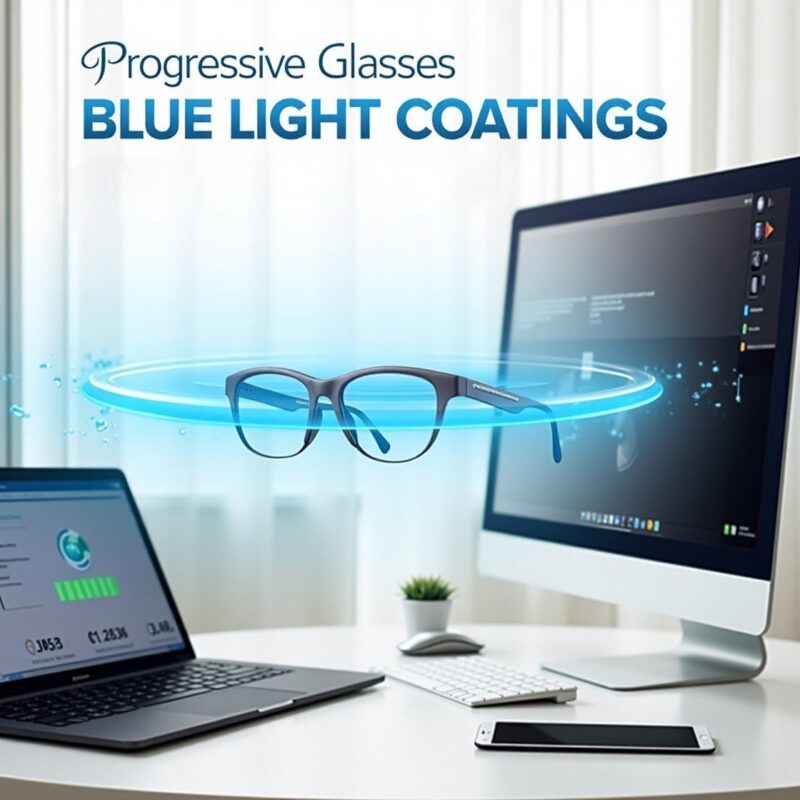
Progressive Glasses with Blue Light Protection
Modern progressive lenses can incorporate blue light filtering technology that blocks 20-50% of harmful blue light while allowing beneficial wavelengths to pass through. This selective filtering helps reduce digital eye strain without affecting color perception or sleep patterns.
Benefits for Digital Device Users
Blue light progressive glasses are particularly beneficial for professionals who spend 6+ hours daily on computers. They help reduce:
- Eye fatigue and strain
- Headaches from prolonged screen time
- Sleep disruption caused by blue light exposure
- Dry eyes associated with reduced blinking
Choosing the Right Blue Light Protection
Look for progressive lenses that offer selective blue light filtering rather than complete blocking. Complete blue light elimination can affect circadian rhythms and color accuracy, while selective filtering targets only the most harmful wavelengths.
Care and Maintenance of Progressive Glasses
Daily Cleaning Best Practices
Proper lens care is crucial for maintaining optical clarity and extending lens life. Start by rinsing lenses with lukewarm water to remove debris, then use a drop of mild dish soap on each lens. Gently rub with your fingers and rinse thoroughly.
Always use microfiber cloths for drying – never paper towels or clothing, which can scratch lens coatings. For quick cleaning when out, use pre-moistened lens wipes specifically designed for eyewear.
Storage and Protection
Store your progressive glasses in a protective case when not in use. Avoid leaving them in hot cars or direct sunlight, which can damage lens coatings and frame materials. Keep them facing up to prevent lens scratches.
Professional Maintenance
Visit your optical provider every 6 months for professional cleaning and adjustment. They have ultrasonic cleaners that remove buildup from hard-to-reach areas like nose pads and hinges. Regular professional maintenance extends the life of your investment.
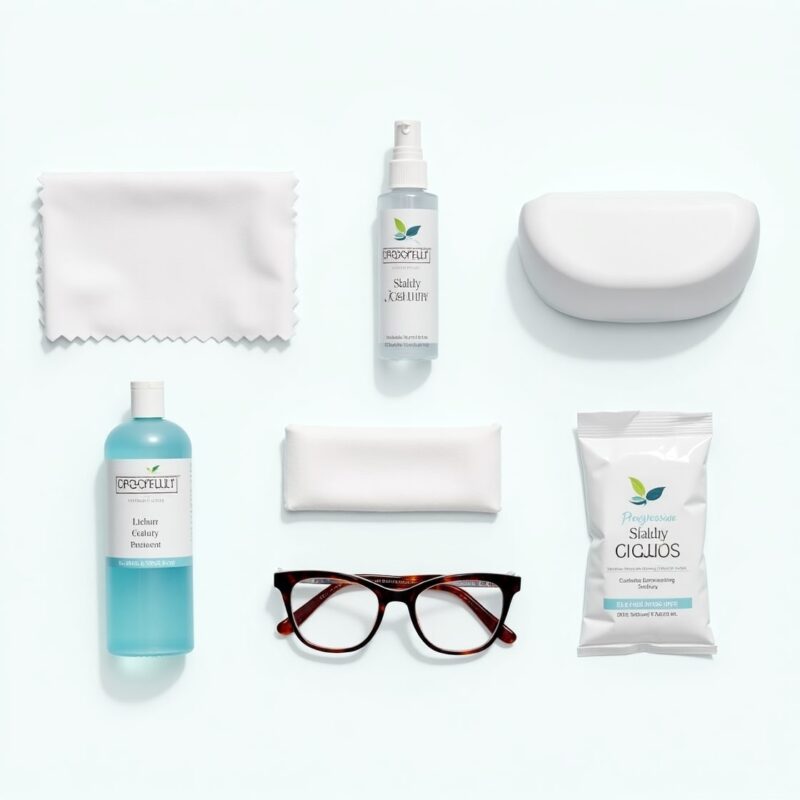
Progressive Glasses for Different Age Groups
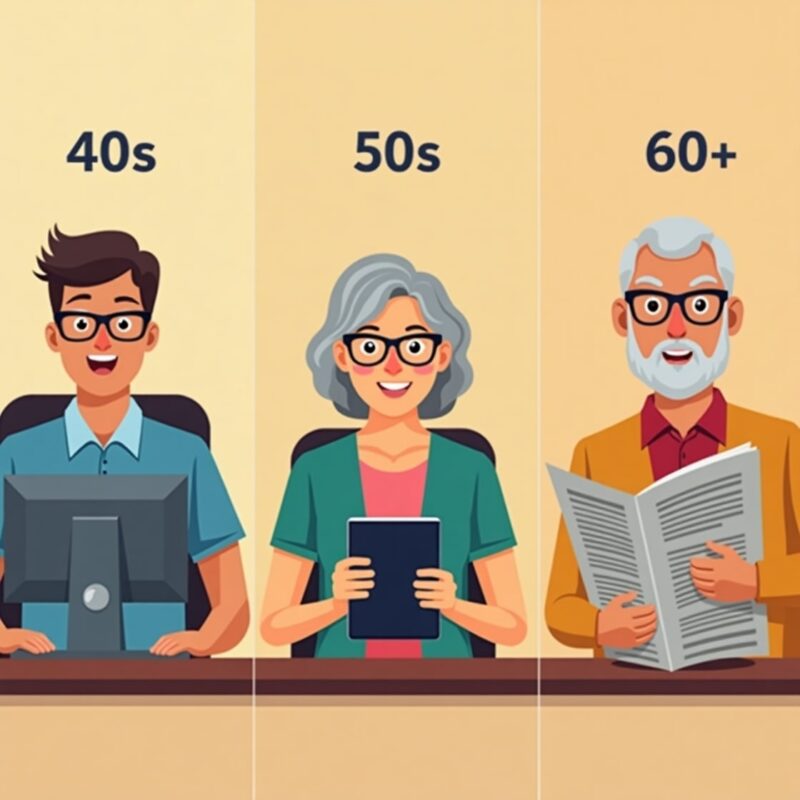
40-50 Age Group: Early Presbyopia
People in their early 40s typically need lower reading additions (+1.0 to +1.5). Standard progressive lenses often work well at this stage, as the prescription difference between distance and near isn’t extreme yet.
50-60 Age Group: Moderate Presbyopia
As presbyopia progresses, reading additions increase to +1.5 to +2.5. Premium progressive lenses become more valuable at this stage, offering wider reading zones and better peripheral vision to accommodate stronger prescriptions.
60+ Age Group: Advanced Presbyopia
Older adults often need +2.5 to +3.5 reading additions. High-quality progressive lenses are essential for comfortable vision, as stronger prescriptions create more peripheral distortion in lower-quality designs.
Considerations for First-Time Wearers
Regardless of age, first-time progressive wearers benefit from premium lens designs that offer easier adaptation. The investment in higher-quality lenses often pays off through faster adjustment and better long-term satisfaction.
Progressive Glasses: Online vs In-Store Shopping
Advantages of Online Shopping
Online progressive glasses shopping offers convenience and competitive pricing. You can browse thousands of frames, read reviews, and often find better deals than traditional optical shops. Many online retailers offer virtual try-on technology and generous return policies.
Benefits of In-Store Purchases
Physical optical shops provide professional fitting, immediate adjustments, and expert guidance. For progressive lenses, proper measurement and fitting are crucial for optimal performance. Opticians can ensure correct pupillary distance, fitting height, and frame alignment.
Hybrid Approach Recommendation
Consider visiting an optical shop for professional measurements and consultation, then purchasing online if desired. Some opticians offer services to verify and adjust online purchases, combining the benefits of both approaches.
Future Trends in Progressive Lens Technology
AI and Machine Learning Integration
Leading manufacturers are incorporating artificial intelligence to create truly personalized progressive lenses. These systems analyze individual eye movement patterns, lifestyle factors, and visual preferences to optimize lens design.
Smart Lens Features
Emerging technologies include progressive lenses with built-in blue light adaptation, automatically adjusting filtration based on ambient light conditions. Some experimental designs even incorporate digital displays for augmented reality applications.

Improved Materials and Coatings
New lens materials offer thinner, lighter progressive lenses with enhanced scratch resistance and UV protection. Advanced anti-reflective coatings now provide oleophobic properties that repel fingerprints and smudges more effectively.
Frequently Asked Questions
-
How much do progressive glasses typically cost?
Progressive glasses range from $175-$250 for basic designs to $600-$1,000+ for premium options. In India, expect to pay ₹1,200-₹20,000 depending on lens quality and features. While initially more expensive than single-vision lenses, progressives often provide better long-term value by replacing multiple pairs of glasses
-
How long does it take to adjust to progressive glasses?
Most people adapt to progressive glasses within 1-2 weeks of consistent wear. Some individuals may need up to a month, especially first-time progressive wearers or those with stronger prescriptions. Premium progressive lenses typically offer faster adaptation due to superior optical design and wider viewing zones
-
Can I buy progressive glasses online safely?
While possible, purchasing progressive glasses online requires accurate measurements including pupillary distance and fitting height. These measurements are crucial for proper lens performance. Many eye care professionals recommend in-store fitting for progressives, especially for first-time wearers, to ensure optimal results
-
What’s the difference between progressive glasses and bifocals?
Progressive glasses provide seamless vision correction across all distances without visible lines, while bifocals have distinct sections separated by a visible line. Progressives offer intermediate vision correction that bifocals lack, making them better for computer use and modern lifestyles, though they typically cost more and require longer adjustment periods
-
Are progressive glasses suitable for computer work?
Yes, progressive glasses work excellently for computer use when properly fitted. The intermediate zone of progressive lenses is specifically designed for arm’s length viewing, making them ideal for screen work. Some manufacturers offer computer-specific progressive designs with enhanced intermediate zones for heavy digital device users
-
Do progressive glasses work for everyone with presbyopia
While progressive glasses work well for most people with presbyopia, they’re not suitable for everyone. Some individuals never adapt to the peripheral distortion inherent in progressive designs, particularly those prone to motion sickness or vestibular disorders. People with significant differences between eye prescriptions may also struggle with progressive adaptation. Your eye care professional can help determine if progressives are right for your specific vision needs and lifestyle
-
How do I know if my progressive glasses prescription is correct?
A correctly prescribed progressive lens should provide clear vision at all distances when looking through the appropriate zones. Signs of an incorrect prescription include persistent headaches after the adjustment period, inability to find clear vision zones, or continued dizziness beyond the first few weeks. If you experience these issues, consult your eye care provider for a prescription verification and possible adjustment
-
Can I get progressive lenses in any frame style?
Not all frame styles accommodate progressive lenses effectively. The frame must have sufficient vertical height (at least 28-30mm) to accommodate all three vision zones. Very small frames, rimless designs, or extreme wrap-around styles may not provide enough space for the progressive lens design to function properly. Your optician can help you select frames compatible with progressive lenses
-
What happens if I lose or break my progressive glasses?
Having a backup plan is important since progressive glasses are essential for daily activities. Keep your prescription information current and consider ordering a backup pair once you’ve successfully adapted to your progressives. Some people maintain older prescription glasses as emergency backups, though this isn’t ideal for optimal vision correction
-
How often should I update my progressive glasses prescription?
Progressive lens prescriptions should be updated every 1-2 years or whenever you notice vision changes. As presbyopia progresses, your near vision requirements increase, typically necessitating stronger reading additions. Regular eye exams help ensure your progressive lenses continue to provide optimal vision correction as your eyes change with age



